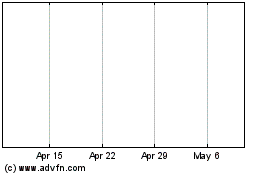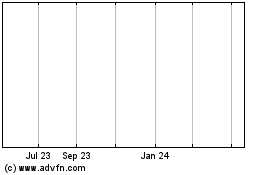Demand for Tech Workers Driving Office Market Momentum, Says New CBRE Report Ranking Top 50 U.S. “Tech Talent” Markets
April 13 2015 - 4:00PM
Business Wire
Emerging tech markets Oklahoma City and
Nashville stand out as top “momentum markets,” posting tech talent
growth rates that rival more established markets like San
Francisco
Tech talent clustering is a growing driver of demand for office
space in both large and small markets across the U.S., according to
a new CBRE Research report, “Scoring Tech Talent,” which
ranks 50 U.S. markets according to their ability to attract and
grow tech talent.
While established tech markets like San Francisco, Washington,
D.C., and Seattle dominated the top spots on the “Tech Talent
Scorecard,” many smaller, up-and-coming markets stood out as top
“momentum markets” based on tech talent growth rates. Oklahoma City
and Nashville had tech talent growth rates of 39 percent between
2010 and 2013, higher than Seattle (38 percent) and just below that
of San Francisco (44 percent) and Baltimore (42 percent). Portland,
OR, and Charlotte both saw tech talent growth rates of 28 percent,
outpacing well-known tech markets like Austin (26.5 percent),
Silicon Valley (20.8 percent) and Los Angeles (13.6 percent).
“Tech talent growth rates are the best indicator of labor pool
momentum and it’s easily quantifiable to identify the markets where
demand for tech workers has surged,” said Colin Yasukochi, director
of research and analysis for CBRE. “Tech talent growth, primarily
within the high-tech industry, has recently been the top driver of
office leasing activity in the U.S.”
Though tech talent comprises only 3.4 percent of the total U.S.
workforce (4.4 million workers), the high-tech industry accounted
for more major U.S. office leasing activity than any sector in both
2013 (13.6 percent) and 2014 (19.0 percent), according to the CBRE
report.
“For the past two years, the high-tech industry has not only
spurred the economy as a whole, but it has been the top driver of
commercial office activity, influencing rents and vacancy in major
markets across the U.S.,” said John Frager, executive managing
director of CBRE’s Tech and Media Practice. “The report showed
Manhattan with the highest office rent and San Francisco with the
lowest vacancy rate of the 50 tech talent markets.”
The top 10 large markets on the Tech Talent Scorecard
(identified as markets with a talent pool above 50,000 tech
professionals) were:
1. Silicon Valley, CA
2. Washington, D.C. 3. San Francisco, CA 4. San Francisco
Peninsula, CA 5. New York, NY 6. Seattle, WA 7. Boston, MA 8.
Baltimore, MD 9. Austin, TX 10. Atlanta, GA
Dallas, Orange County, Chicago and Raleigh-Durham took the 11,
12, 13 and 14 spots on the list before a small market—defined as a
market with a tech talent labor pool of less than 50,000—made its
way onto the list. The top-ranked small markets included:
15. Oakland, CA 16. Edison, NJ 23. Columbus,
OH 25. Salt Lake City, UT 26. Portland, OR 27. Newark, NJ 29. Long
Island, NY 30. Kansas City, MO 31. Charlotte, NC 33. Cincinnati, OH
The report also looked at which markets present the greatest
cost for occupiers based on wages paid to employees and rent paid
for office space. CBRE Research combined these two costs for a
“typical” 500-person tech firm needing 75,000 sq. ft. of office
space for each market and found that, for large markets, Silicon
Valley is the highest cost and Detroit is the lowest cost. For
smaller markets, Oakland is the highest cost and Oklahoma City is
the lowest cost.
The CBRE report also identified various characteristics that are
shared by tech talent markets:
- Gender Diversity: The U.S.
average breakdown for tech talent occupations is 76.2 percent male
and 23.8 percent female. Half of tech talent markets have a greater
concentration of women in these occupations when compared with the
U.S. average, but the numbers are still imbalanced. The most
gender-diverse tech talent market is Philadelphia, where females
occupy 31 percent of tech talent occupations.
- Education: Nearly 75 percent of
the top 50 tech talent markets have an educational attainment rate
above the national average. New York, Washington, D.C., and Los
Angeles topped the list for the most tech degrees completed in a
two-year period. When it comes to small markets, Columbus was the
standout in this area, besting large markets like Dallas/Ft. Worth
and Philadelphia in the number of tech degrees completed in the
last two years. These numbers are an indication of future tech
talent growth.
- Millennials: The presence of
millennials in the workforce has contributed to the growth of tech
talent labor pools. In Boston, millennials make up more than 25
percent of the total population. In Washington, D.C., the
millennial population has increased by 26.5 percent since
2009.
“Though highly concentrated within the high-tech services
industry, tech talent is not limited to any one type of company and
can be found across all industry sectors. In fact, more than 60
percent of tech talent jobs are located outside of the core
high-tech industry and these workers help generate innovation and
advances that can boost the whole economy, including the commercial
real estate market,” said Yasukochi.
To view the interactive report, please visit
www.cbre.com/techtalent2015.
About CBRE Group, Inc.
CBRE Group, Inc. (NYSE:CBG), a Fortune 500 and S&P 500
company headquartered in Los Angeles, is the world’s largest
commercial real estate services and investment firm (in terms of
2014 revenue). The Company has more than 52,000 employees
(excluding affiliates), and serves real estate owners, investors
and occupiers through more than 370 offices (excluding affiliates)
worldwide. CBRE offers strategic advice and execution for property
sales and leasing; corporate services; property, facilities and
project management; mortgage banking; appraisal and valuation;
development services; investment management; and research and
consulting. Please visit our website at www.cbre.com.
CBRE Group, Inc.Christy Ingle,
949.725.8591christy.ingle@cbre.comorCorey Mirman,
212.984.6542corey.mirman@cbre.com
CBRE Group, Inc. (NASDAQ:CBRE)
Historical Stock Chart
From Mar 2024 to Apr 2024

CBRE Group, Inc. (NASDAQ:CBRE)
Historical Stock Chart
From Apr 2023 to Apr 2024
